Going Home Isn’t All It’s Cracked Up to Be: Twilight: 2000’s American Campaign, Part I
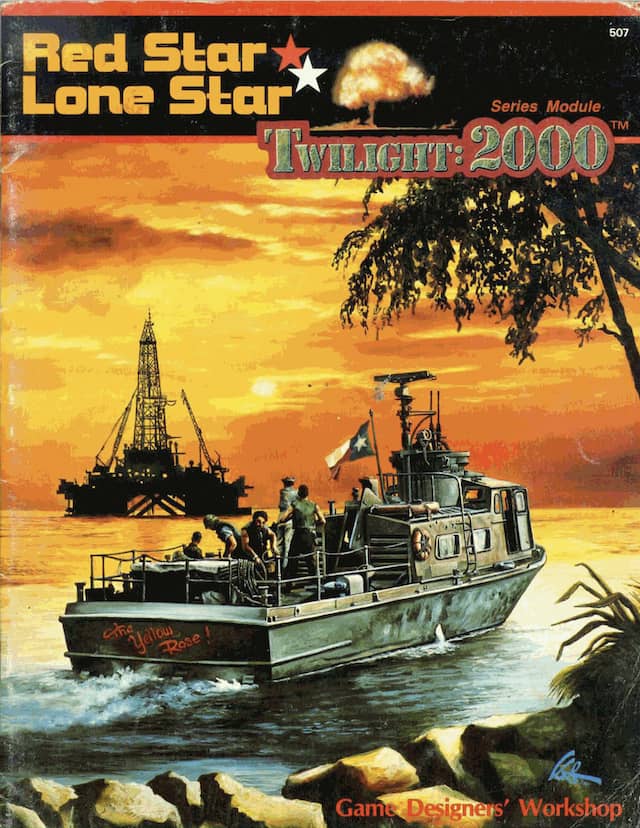
This is the first of three articles covering GDW’s published adventures in the “American Campaign” for Twilight: 2000’s first edition.
The published adventures for Twilight: 2000 did not stop with the players returning home in Going Home, the final adventure in what is referred to as the Polish Campaign. A series of nine adventures followed, all set in the United States — or what the United States as become the setting. The first three published adventures, Red Star/Lone Star, Armies of the Night, and Allegheny Uprising presume the players did manage to return to the United States from Europe.
Unlike the linked — albeit loosely — adventures of the Polish Campaign, with its opening escape, fleeing to Krakow, working toward Warsaw, and then eventual crossing into Germany, these three first adventures of the American campaign exist independently. An enterprising game master (GM) and players could find a way to connect them, though the distances are vast — particularly for Red Star/Lone Star and the other two — at least vast in a post-apocalyptic world.
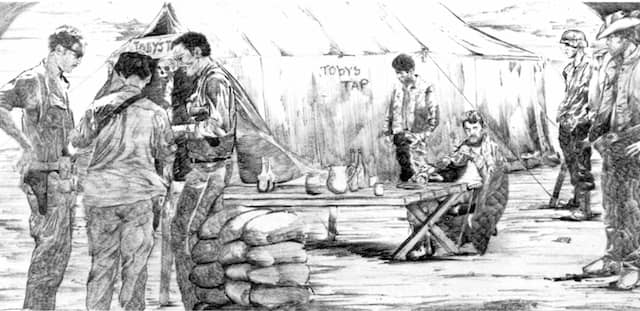
For those not familiar with Twilight: 2000, it was an RPG published in 1984 by GDW. Set in the then somewhat distant future of 2000, it presumed that the Soviet Union did not collapse in the early 90s. Still tied into the Cold War ethos of the 1980s, it posits a hot World War III starting in the late 90s and escalating to a nuclear exchange. However, it is not the massive bombardment presumed in the MAD doctrine — rather, the world inches across into nuclear holocaust.
The players start out in the US 5th Army Division in Poland. An offensive in the 2000 meets with disaster and the players are left, stranded in enemy territory with no support. It is one of the classic set ups for fantastic gaming. It also operates very much in a sandbox — in that the players are tasked with determining what will happen next. Where do they want to go? What do they want to do? How will they survive?
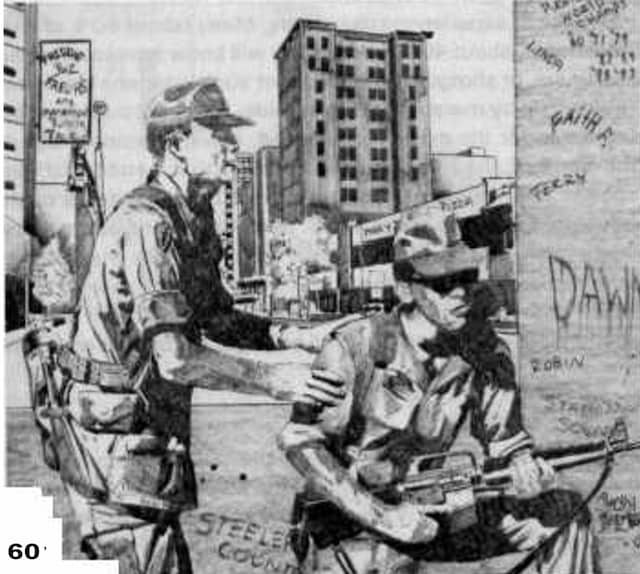
The game presumes a strong desire to return home, which makes sense, but it is not a foregone conclusion. Presuming the players do follow that impetus, however, the American campaign of adventures is the logical next step in a playing group’s adventures. That said, a gaming group could start in the United States and rely on these adventures, but something is gained by ensuring the players are unfamiliar with what has happened to the United States while they were overseas. Sure, they will know that the government basically fractured in half, with the military essentially operating what is called the MilGov and the remnants of the civilian government (Washington, D.C., was nuked with only 10 minutes warning) called the CivGov.
Both governments lost effective control over swathes of territory. Local governments themselves were unable to meet the burden of the collapse of infrastructure delivering food, oil, gas, and other precious commodities. Warlords and bandits held sway of masses of refugees and towns.
These adventures function more as sourcebooks than adventures, at least in the traditional sense — rich with setting information, they still retain much of the sandbox element that makes Twilight: 2000 a special game.
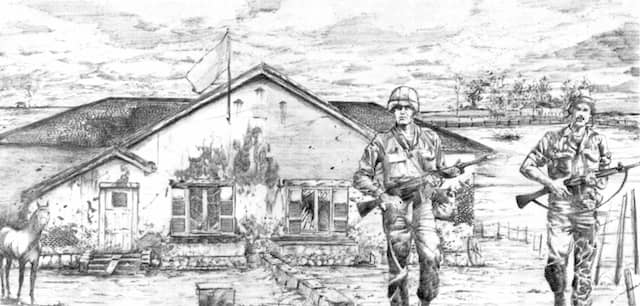
In Red Star/Lone Star, the players find themselves in Texas, likely because their ship coming from the Germany diverted from its planned route. The adventure even suggests the players boarded a Brazilian ship named Sao Sebastiao, which stopped en route to the southern latitudes. Regardless of how the GM manages to get the players to Texas, it all starts in Port Lavaca.
The adventures describes in much detail southeastern Texas during this time — from San Antonio to Laredo to Brownsville to Corpus Christi. Port Lavaca is northeast of Corpus Christi. The first mover in the adventure is “Texas Bill” Kingsley, a rancher whose son, “Bill Bob,” and daughter-in-law, Kathy Jean, are kidnapped. With no ransom forthcoming, Texas Bill needs some capable hands to find his son and wife.
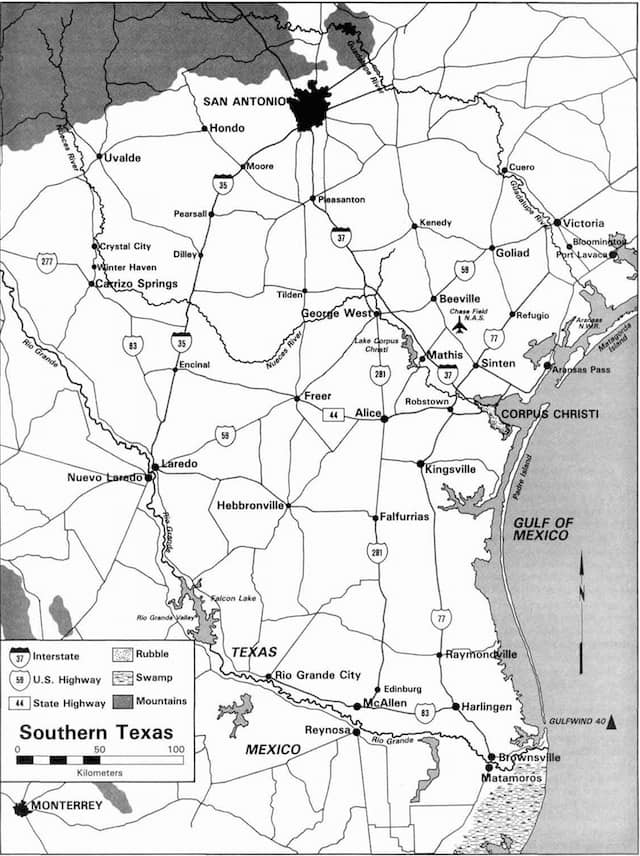
The real thrust of the adventure, however, is that Bill Bob was kidnapped by his uncle, Thomas, and El Jefe, head of an organized crime family that established itself with access to several million gallons of oil. Bill Bob was kidnapped to bring Gulfwind 40 — an offshore oil rig — back up and running, bringing oil to the shore, and re-affirming El Jefe’s grip on southern Texas.
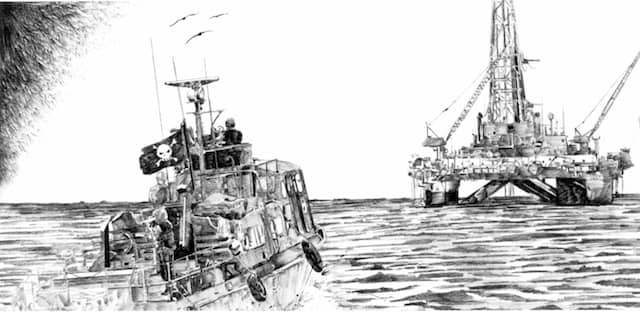
However, the players will encounter many groups. The Mexican army invaded in 1998 after a series of government changes. However, the Mexican army itself is divided between Federales (those loyal to the current government in Mexico City — such as it is) and the Constitucionales, who view the current government as illegitimate. Rival Marxists and nationalists, far-right parties exist as well, determined to take advantage if they can to establish power.
A Soviet army based in Cuba took the opportunity to join the Mexican army’s invasion — mostly to ensure that it entered US territory and thus — hopefully — avoid being struck by a nuke. The remains of that army occupy San Antonio.
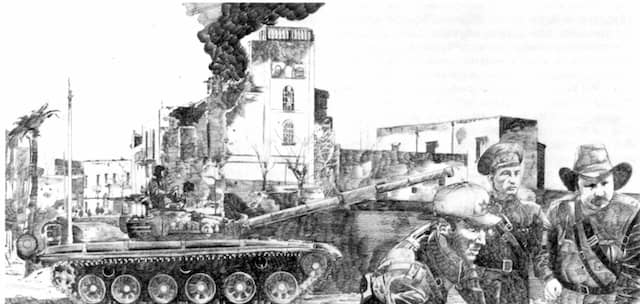
Meanwhile, the American population struggles to find a meaningful alternative. The more palatable group are the Grangers, which Texas Bill is the nominal head. A loosely formed coalition that is intent on stopping marauders and establishing a Texas Republic. Players are likely to encounter far right, anti-Mexican groups as well — a disturbing but realistic detail. This nativist and racist component also figures into Armies of the Night. GMs are advised to be careful with the material — while an important fact of life, it could also be troubling to players. (And it is not necessary to play the game, but it is a component of dealing with the collapse of society.)
Armies of the Night is based in New York City. The set up for this adventure is that MilGov seeks to reassert control of New York City, but with the nuking of large parts of New Jersey, government collapsed when the influx of food into the city stopped. Refugees clogged the routes fleeing out of the city. Interestingly, New York City itself was not nuked. The New Jersey targets were its oil refineries and factories. Staten Island was devastated, but Manhattan was comparatively untouched.
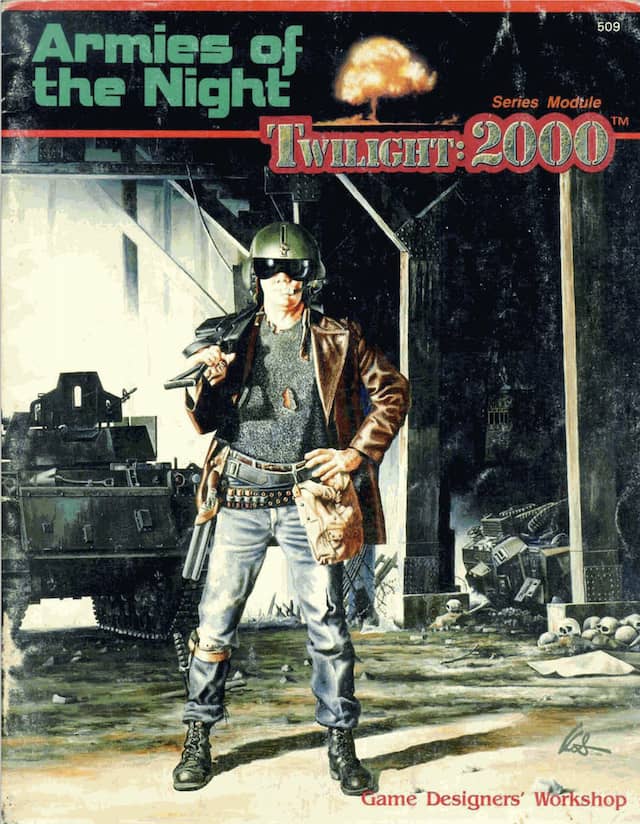
The players are sent into the city the goals of establishing a base of operations, attempting to take a census of the population, and locating the gold once held in the Federal Reserve Bank. This last mission is the result of a witness who survived an ambush on a caravan — a Sergeant Carter. He claims a Captain Kellogg — still in the city — has information about this gold.
New York City has not fared well in the years since the nuke (December 2, 1997). But without an influx of food, the loss of electricity, and no gas, the population has plummeted, and the city itself is controlled by a number of gangs and factions. Central Park is a walled farm. Any scrap of soil is farmed. The subways are flooded — and are the source of water for most of the populace.
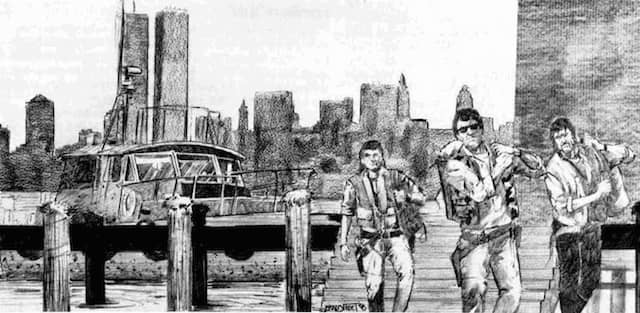
A sadistic warlord calling himself Hizzoner rules much of Manhattan, including portions of Central Park — and thus with the only real source of food. Another warlord, calling himself the Duke, is Hizzoner’s primary rival, but lacks the strength — for now — of eliminating Hizzoner and his loyalists.
Neither is interested in MilGov or CivGov returning to power.
The players are free to conduct this mission how they see fit. An overview of Manhattan and its factions are provided to give the GM plenty of grist for adventures. While most of the city’s buildings are looted for the first few floors, many taller buildings remain unlooted in the upper floors because of the challenge of climbing all those stairs (remember, no electricity to run the elevators). In many ways, the GM can craft any number of adventures in New York City, exploring the ruins of what many consider the greatest city on the planet. All sorts of social themes can be explored. And, of course, every proud New Yorker would expect the city’s inhabitants to overcome and re-establish the city’s greatness — something the players can play a hand in.
Allegheny Uprising starts off with a straightforward mission from the CivGov in Maryland: lead an expedition to find a cache called SRS-17374-2. This stockpile consists of tools, rare minerals, medical supplies, ammo, gasoline, and so no. Precious items in the world of Twilight: 2000. A secondary mission is to provide intelligence about western Pennsylvania in the hopes of re-establishing control of Pittsburgh and surrounding areas. The players will be required to take with them two NPCs — a smart move to help ensure the players do not just run with the stockpile — at least, not without potential repercussions or questionable moral decisions.
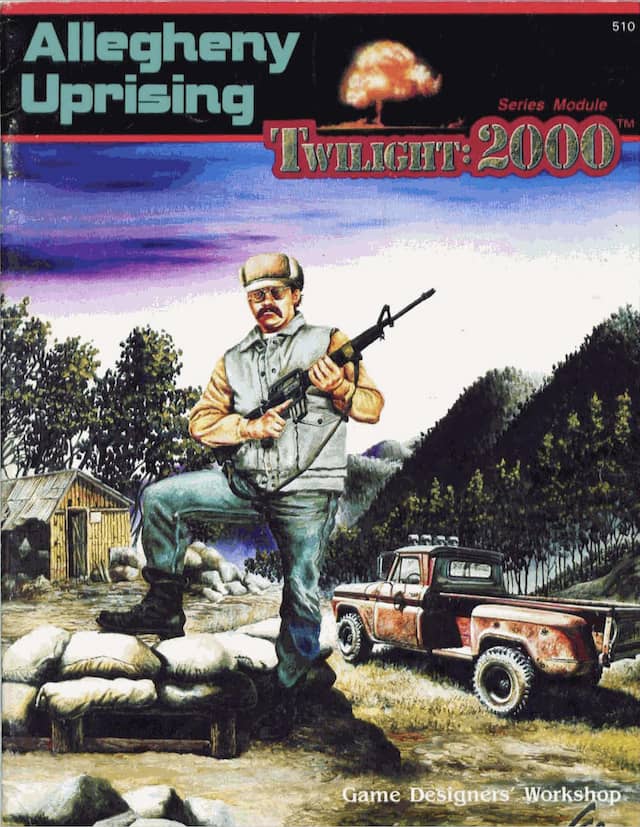
Western Pennsylvania is run by a number of warlords and marauder bands, and the adventure goes out of its way to suggest the players could help form a popular uprising against these bandits — perhaps bringing a measure of peace and security to a desperate people.
The primary opponents to the player’s expedition are the warlords, including someone simply known as The White Death, the “senior military advisor” to Jeremy Fitzpatrick, a former congressperson who has knowledge of SRS-17374-2 — and, thus, a necessary target for the players to find and engage with.
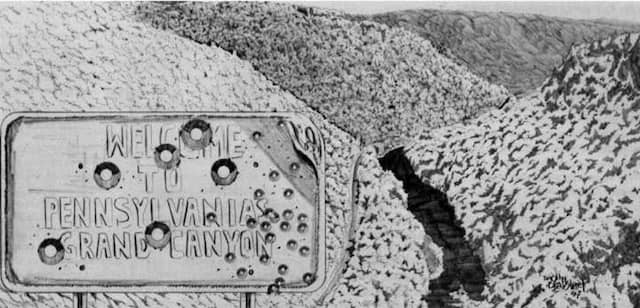
Others include Bradley’s Irregulars and a host of local militias that could be hostile or friendly depending on how the players interact with them.
The adventure provides several locations for the cache, depending on where the GM wants to place it and affording flexibility depending on the player actions. Once the players find the cache, they can live up to the mission’s goals and radio their location — and hold out until the convoy of the 228th Infantry arrives to collect it. Certainly, an epic battle will ensue.
All three adventures are essentially set up the same. Major NPCs have both stats and motivations. A number of minor NPCs can be slotted in by the GM as necessary. The adventures rely heavily on exploration and travel, which generate encounters and the revealing of information in the form of rumors. Encounters cover the gamut of enemy groups, friendlies, people in need of aid, wildlife, and so on. Some are easier to avoid than others.
Additionally, the adventures divide the areas into “sections,” for which they provide broad information about the major factions and locations along with specific encounters in that area.
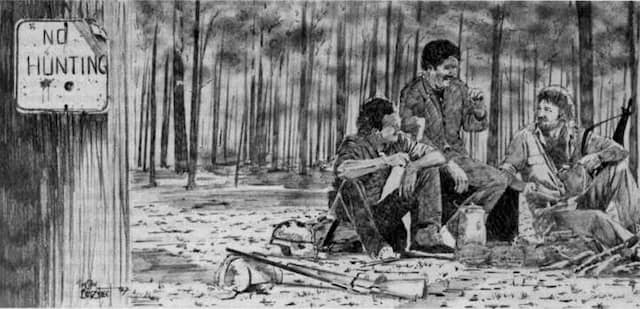
Each of these adventures is quite good and lives up to the sandbox play of Twilight: 2000. Each provides interesting and different types of adventures and missions, along with establishing a setting that can carry on beyond the adventure and providing dozens of plot hooks, interesting NPCs, and troublesome encounters. Perhaps the players become leaders in western Pennsylvania and help to re-establish an orderly, civilian rule. Perhaps the secure Gulfwind 40 for themselves and replace El Jefe as a dominating crime lord in southeast Texas.
Interesting possibilities and interesting consequences. Isn’t that what RPGs are all about?
You can pick up these adventures — in fact, all of Twilight: 2000’s sourcebooks, adventures, and rules for $35.00 from Far Future Enterprises.
Our previous coverage of GDW’s Twilight: 2000 includes:
Exploring Post-Apocalyptic Poland in Twilight: 2000
Twilight: 2000 — Roleplaying in a Post-Nuclear Holocaust World
Twilight: 2000‘s Polish Campaign, Part II
Twilight: 2000‘s Polish Campaign, Part II
Twilight: 2000‘s Polish Campaign: Part III
Going Home Isn’t All it’s Cracked Up to Be: Twilight: 2000’s American Campaign, Part I
From the Mountains to the Oceans: Twilight 2000‘s American Campaign, Part II
Reckoning: Twilight: 2000‘s American Campaign, Part III
Patrick Kanouse encountered Traveller and Star Frontiers in the early 1980s, which he then subjected his brother to many games of. Outside of RPGs, he is a fiction writer, avid tabletop roleplaying game master, and new convert to war gaming. His last post for Black Gate was Disaster Adventure in Space: Coriolis’ The Last Voyage of the Ghazali. You can follow him and his brother at Two Brothers Gaming as they play any number of RPGs. Twitter: @twobrothersgam8. Facebook: Two Brothers Gaming.
My home gaming gang never got “home” in our Twilight:2000 gaming. Thank you for reviewing these really intriguing sourcebook/adventure books, Mr. Kanouse.
I wonder if Armies of the Night had any influence on Brian Wood’s graphic novel DMZ, which is likewise set in a depopulated Manhattan caught between warring factions (US federal troops, rebel “Free States Army”).
Thanks Eugene for reading and commenting. My brother never made it back to the US in our campaign–but then again, he played a Soviet soldier. 🙂
I’ve not read DMZ; I’ll have to check it out.
In the Twilight: 2000, First Edition, materials from FFE, Marc Miller included a letter written by Frank Chadwick in response to a plagiarism claim by another publisher around Red Star/Lone Star–and Frank’s response is wonderful. An interesting little tidbit….
I think one cannot write of “*an* American campaign”, when these modules are so widely separated in space. Pretty much each one of them, and the ones that follow, are so far apart (and so large a sandbox on their own) that each one is its own campaign.
FWIW, Two of my Polish campaign groups made it to Going Home, but none of those characters crossed the ocean to play in America. I did run Lone Star and start Allegheny once each, but neither featured characters continuing from Europe.
Lee, thanks for reading and commenting! Agreed, to call it a “campaign” is not accurate, but I’m using what I’ve heard generally in the community for what that string of adventures is called.